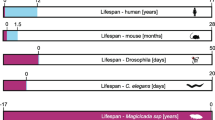Abstract
It is well documented that poor early nutrition can have profound negative effects on adult life-history traits. However, it has also been demonstrated that organisms can undergo compensatory resource allocation strategies (such as an accelerated growth rate) if food availability improves, so as to mitigate the effects of the poor early conditions. Previous research has indicated that elevated growth rates can incur costs in the longer term, such as an increased rate of senescence and shorter lifespan. We tested whether a phase of compensatory growth after a period of reduced food availability earlier in life affected the sexual attractiveness of adult male green swordtails Xiphophorus helleri, a species in which it has previously been documented that females prefer larger-bodied and longer-tailed males. The experiment compared the attractiveness of size-matched brothers that had experienced contrasting growth trajectories as juveniles; the experiments were initially conducted in the middle of a male’s sexually reproductive life and were then repeated towards the very end of life. At both ages, males that had undergone compensatory growth were equally as attractive as their brothers that had grown normally. These results suggest that the growth compensation benefits males through an increase in their attractiveness over that which they would have had if they had remained on their original growth trajectory. The lack of change in relative attractiveness with age indicates that the compensation does not cause greater deterioration in secondary sexual characters at older ages than in continuously well-fed males.





Similar content being viewed by others
References
Ali M, Nicieza A, Wootton RJ (2003) Compensatory growth in fishes: a response to growth depression. Fish Fish 4:147–190
Basolo AL (1990a) Female preference for male sword length in the green swordtail, Xiphophorus helleri (Pisces, Poeciliidae). Anim Behav 40:332–338
Basolo AL (1990b) Female preference predates the evolution of the sword in Swordtail fish. Science 250:808–810
Basolo AL (1998) Shift in investment between sexually-selected traits: tarnishing of the silver spoon. Anim Behav 55:665–671
Beaugrand JP, Goulet C, Payette D (1991) Outcome of dyadic conflict in male green swordtail fish, Xiphophorus helleri—effects of body size and prior dominance. Anim Behav 41:417–424
Billerbeck JM, Lankford TE, Conover DO (2001) Evolution of intrinsic growth and energy acquisition rates. I. Trade-offs with swimming performance in Menidia menidia. Evolution 55:1863–1872
Birkhead TR, Fletcher F, Pellatt EJ (1999) Nestling diet, secondary sexual traits and fitness in the zebra finch. Proc R Soc Lond B 266:385–390
Blount JD, Metcalfe NB, Arnold KE, Surai PF, Devevey GL, Monaghan P (2003) Neonatal nutrition, adult antioxidant defences and sexual attractiveness in the zebra finch. Proc R Soc Lond B 270:1691–1696
Chong ASC, Ishak SD, Osman Z, Hashim R (2004) Effect of dietary protein level on the reproductive performance of female swordtails Xiphophorus helleri (Poeciliidae). Aquaculture 234:381–392
Hales CN, Ozanne SE (2003) The dangerous road of catch-up growth. J Physiol 547:5–10
Holmgren K (2003) Omitted spawning in compensatory-growing perch. J Fish Biol 62:918–927
Jennions MD, Petrie M (1997) Variation in mate choice and mating preferences: a review of causes and consequences. Biol Rev 72:283–327
Lessells CM, Boag PT (1987) Unrepeatable repeatabilities—a common mistake. Auk 104:116–121
Lindström J (1999) Early development and fitness in birds and mammals. Trends Ecol Evol 14:343–348
Lindström J, Metcalfe NB, Royle NJ (2005) How are animals with ornaments predicted to compensate for a bad start in life? A dynamic optimization approach. Funct Ecol 19:421–428
Marcus JM, McCune AR (1999) Ontogeny and phylogeny in the Northern swordtail clade of Xiphophorus. Syst Biol 48:491–522
Metcalfe NB, Monaghan P (2001) Compensation for a bad start: grow now pay later? Trends Ecol Evol 16:254–260
Metcalfe NB, Monaghan P (2003) Growth versus lifespan: perspectives from evolutionary ecology. Exp Gerontol 38:935–940
Morgan IJ, Metcalfe NB (2001) Deferred costs of compensatory growth after autumnal food shortage in juvenile salmon. Proc R Soc Lond B 268:295–301
Nicieza AG, Metcalfe NB (1997) Growth compensation in juvenile Atlantic salmon: responses to depressed temperature and food availability. Ecol 78:2385–2400
Ozanne SE, Hales CN (2004) Lifespan-catch-up growth and obesity in male mice. Nature 427:411–412
Qvarnström A, Forsgren E (1998) Should females prefer dominant males? Trends Ecol Evol 13:498–501
Rosenthal GG, Evans CS (1998) Female preference for swords in Xiphophorus helleri reflects a bias for large apparent size. Proc Natl Acad Sci USA 95:4431–4436
Royle NJ, Lindström J, Metcalfe NB (2005) A poor start in life negatively affects dominance status in adulthood independent of body size in green swordtails Xiphophorus helleri. Proc R Soc Lond B 272:1917–1922
Royle NJ, Lindström J, Metcalfe NB (2006) Effect of growth compensation on subsequent physical fitness in green swordtails (Xiphophorus helleri). Biol Lett 2:39–42
Ryan MJ (1988) Phenotype, genotype, swimming endurance and sexual selection in a swordtail (Xiphophorus nigrensis). Copeia 2:484–487
Wagner WE Jr (1998) Measuring female mating preferences. Anim Behav 55:1029–1042
Acknowledgements
CAW was funded by a NERC studentship, NJR by a BBSRC grant to JL & NBM. We are very grateful to John Laurie for animal husbandry. All experiments complied with the current laws of the UK. We thank two referees and the editors for helpful comments that improved the manuscript.
Author information
Authors and Affiliations
Corresponding author
Additional information
Communicated by C. St Mary
Rights and permissions
About this article
Cite this article
Walling, C.A., Royle, N.J., Metcalfe, N.B. et al. Early nutritional conditions, growth trajectories and mate choice: does compensatory growth lead to a reduction in adult sexual attractiveness?. Behav Ecol Sociobiol 61, 1007–1014 (2007). https://doi.org/10.1007/s00265-006-0333-7
Received:
Revised:
Accepted:
Published:
Issue Date:
DOI: https://doi.org/10.1007/s00265-006-0333-7




